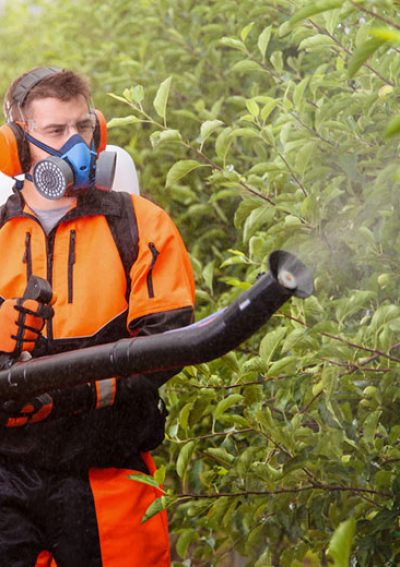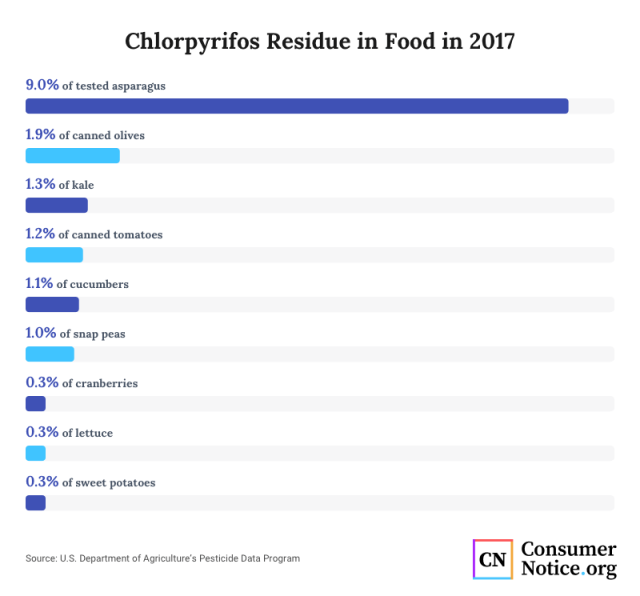Chlorpyrifos
Chlorpyrifos is a pesticide used to kill insects, mites and ticks. In scientific terms, it’s known as an organophosphate insecticide, acaricide and miticide because it kills pests by inhibiting the action of acetylcholinesterase, a critical enzyme that keeps the nervous system working properly.

Chlorpyrifos isn’t exactly a household name, but the common agricultural pesticide can drift from treated fields into nearby homes and schools, exposing families and children to its toxic effects.
First put on the market in 1965, chlorpyrifos is an organophosphate manufactured by Dow AgroSciences. The toxic pesticide can kill everything from termites to roundworms to weevils to mosquitos.
At one time, it was used to eradicate pests both in homes and across farms. Today, the chemical is used on about five dozen different food crops — corn being the largest. It’s also used on golf courses.
By inactivating the acetylcholinesterase enzyme, the potent neurotoxin causes an accumulation of the neurotransmitter acetylcholine in the nerve endings, which overstimulates the neurons. Eventually, this leads to neurotoxicity and death.
But bugs aren’t the only susceptible organisms. Chlorpyrifos can also have serious adverse effects on humans.
People who accidentally inhale or ingest high doses of chlorpyrifos may develop neurotoxicity, which can manifest with symptoms such as nausea, dizziness and confusion. Extremely high exposures to the chemical can lead to respiratory paralysis and death. The controversial chemical has also been linked to developmental problems and low IQs in children.
Because of these effects, several states have moved to ban the use of chlorpyrifos, and the Environmental Protection Agency has also considered doing so.
How People Are Exposed
Even though the indoor use of chlorpyrifos is limited to insect bait traps such as those used to kill ants and roaches, people can be exposed to the chemical in other ways. If you live near an agricultural area, chlorpyrifos dust can drift from nearby fields into your home, school or office.
Bonnie Wirtz and her family were exposed to toxic levels of chlorpyrifos in 2012, when a crop duster flying overhead sprayed a farm adjacent to their Minnesota home, according to Chemical & Engineering News (C&EN). Wirtz told the news publication that after the airplane deposited the chemicals, a white mist started coming through their air-conditioning unit and she began coughing and stumbling and had trouble breathing.
Wirtz’s husband rushed her and their 8-month-old baby to the emergency department, where they learned that they had been sickened by chlorpyrifos. Air samples later revealed chlorpyrifos levels four times higher than the safe limits of exposure for a 1-year-old child. Wirtz’s son was later diagnosed with a neurodevelopmental disorder.
Farm workers have also been stricken by chlorpyrifos poisoning. In May 2017, a group of cabbage field workers fell ill after a cloud of chlorpyrifos drifted over from a nearby mandarin orange grove. According to the Las Vegas Sun, workers could taste the strong odor of the chemical in their throats as the symptoms such as tingling lips, itchy skin, watery eyes and headache overtook them.
While some workers scattered to find relief from the chemical, others were too afraid to walk off the job. Those who stayed developed nausea, vomiting, dizziness and other symptoms. Some workers fainted and others collapsed into convulsions. Rescuers came and set up a decontamination area several hundred yards away and shuttled the poisoning victims off to an area hospital.
Pesticide Residue in Food
Fruits and vegetables that we buy and eat may also contain chlorpyrifos residue. The U.S. Department of Agriculture’s Pesticide Data Program reported finding chlorpyrifos residue in nearly 9 percent of the asparagus it tested in 2017. The residue was also present in 0.3 percent of cranberries, 1.1 percent of cucumbers, 1.3 percent of kale, 0.3 percent of lettuce, 1.9 percent of canned olives, 1 percent of snap peas, 0.3 percent of sweet potatoes and 1.2 percent of canned tomatoes.

A 2017 annual summary by the USDA’s Pesticide Data Program reported finding chlorpyrifos residue in several fruits and vegetables it tested including:
- Applesauce
- Asparagus
- Cranberries
- Cucumbers
- Kale
- Lettuce
- Canned olives
- Snap peas
- Sweet potatoes
- Canned tomatoes
Although the detected residue was below the Environmental Protection Agency’s tolerance level for most of the produce, studies suggest that chlorpyrifos may affect neurodevelopment at levels below toxicity guidelines.
A 2012 study in the journal Environmental Health noted that children may be more susceptible to the effects of chlorpyrifos than adults because of “biological factors and exposure settings.” The report notes that animal studies have shown the chemical disrupts cells in the brain and nervous system and that the effects are “particularly enhanced in early development.”
Health Risks
Dow AgroSciences, farmers and other proponents of the pesticide argue that chlorpyrifos is essential to mass food production. However, exposure to chlorpyrifos can cause a range of adverse health effects.
According to the National Pesticide Information Center at Oregon State University, exposure to small amounts of the chemical can cause a runny nose, tearing of the eyes, excessive salivation, drooling, headaches, dizziness and nausea.
As exposure levels increase, an individual may develop vomiting, abdominal cramping, tremors, weakness, muscle twitching, loss of coordination, diarrhea and vision loss. Severe poisoning can cause a loss of control of one’s bladder and bowels, unconsciousness, trouble breathing and paralysis.
Studies also suggest that young people may be more sensitive to chlorpyrifos exposure than adults, and some research has linked the potent neurotoxin to developmental delays and defects in children.
A 2006 study published in the journal Pediatrics looked at 254 children who were exposed to chlorpyrifos in the womb. It found that by 3 years old, children with high exposure performed 6.5 points lower on a psychomotor development assessment and 3.3 points lower on a specific mental development assessment than those with lower exposure levels.
A 2014 study by researchers at the University of California, found that babies who were born to mothers who lived less than one mile from fields treated with organophosphates and other pesticides were two-thirds more likely to be diagnosed with autism. The risk was higher for babies who were exposed to pesticides during the last three months of gestation, and it was higher among those exposed to chlorpyrifos during the second trimester.
Bans and Legal Battles
In 2000, the Environmental Protection Agency and Dow reached an agreement to ban most household uses of chlorpyrifos, except in ant and roach baits and fire ant mound treatments. And in 2002, the EPA restricted the use of the chemical on citrus, tree nuts and some additional crops.
The environmental watchdog agency endorsed a wholesale ban on the use of the pesticide in 2015 under the Obama administration. But in 2017, then-EPA Administrator Scott Pruitt rejected a ban, arguing that the chemical is critical to U.S. agriculture and the world’s food supply.
In a statement announcing his decision, Pruitt said that thousands of American farmers rely on chlorpyrifos, and he attacked the methodology used by the Obama administration. He said his decision reflected a return to “using sound science in decision-making rather than predetermined results.”
Pruitt, who resigned in 2018, may not get the final say, however. In April 2019, the U.S. Court of Appeals for the Ninth Circuit gave the EPA 90 days to act on demands by environmental groups to ban the pesticide. The League of United Latin American Citizens and other groups first brought the lawsuit against the EPA in 2007, when the federal agency denied their petition to remove the chemical from use.
As that battle plays out, some states have moved to ban the pesticide. Hawaii was the first to do so in 2018, though the ban won’t go into effect until 2022. And state lawmakers in New York recently approved legislation to ban the pesticide beginning in 2021. New York Gov. Andrew Cuomo is expected to sign the bill into law.
California announced in May 2019 that it would ban the chemical within two years. Other states — including Connecticut, Maryland, New Jersey, Oregon and Vermont — have also considered banning the pesticide.
Avoiding Chlorpyrifos
Because of its widespread use, it’s difficult to avoid chlorpyrifos, but eating organic fruits and vegetables may help.

A small 2019 study published in the journal Environmental Research examined the urine samples of 16 adults and children after they switched to an organic diet and found significant reductions in pesticides, including chlorpyrifos. The California researchers also concluded that chlorpyrifos food residue “would likely decrease” if the EPA bans the agricultural use of the chemical.
If you work with any products that contain chlorpyrifos, be sure to wear the proper personal protective equipment. According to the EPA, this includes chemical resistant gloves, coveralls and respirators. People without protection should not enter fields for 24 hours to five days after they’ve been treated.
36 Cited Research Articles
Consumernotice.org adheres to the highest ethical standards for content production and references only credible sources of information, including government reports, interviews with experts, highly regarded nonprofit organizations, peer-reviewed journals, court records and academic organizations. You can learn more about our dedication to relevance, accuracy and transparency by reading our editorial policy.
- Agency for Toxic Substances and Disease Registry. (1997). Retrieved from https://www.atsdr.cdc.gov/toxfaqs/tf.asp?id=494&tid=88
- Alavanja, M.C.R. (2009, October-December). Pesticides Use and Exposure Extensive Worldwide. Retrieved from https://www.ncbi.nlm.nih.gov/pmc/articles/PMC2946087/
- Bouchard, M.F. et al. (2011, August 1). Prenatal Exposure to Organophosphate Pesticides and IQ in 7-Year-Old Children. Retrieved from https://ehp.niehs.nih.gov/doi/10.1289/ehp.1003185
- Branch, J. & Lipton, E. (2018, December 27). Dismissing science has put these California workers at risk. Retrieved from https://lasvegassun.com/news/2018/dec/27/dismissing-science-has-put-these-california-worker/
- CalEPA. (2019, May 8). California Acts to Prohibit Chlorpyrifos Pesticide. Retrieved from https://calepa.ca.gov/2019/05/08/california-acts-to-prohibit-chlorpyrifos-pesticide/
- CBS News. (2019, May 8). California to ban controversial pesticide blamed for harming child brain development. Retrieved from https://www.cbsnews.com/news/california-bans-chlorpyrifos-pesticide-agriculture-state-child-brain-development/
- Chase-Lubitz, J. (2019, April 19). Appeals court orders EPA to act on demands to ban chlorpyrifos. Retrieved from https://www.politico.com/story/2019/04/19/epa-chlorpyrifos-court-3115794
- Cuthbert, L. (2018, August 10). EPA Must Ban Dangerous Insecticide Chlorpyrifos: What Is It? Retrieved from https://www.nationalgeographic.com/environment/2018/08/chlorpyrifos-insecticides-pesticides-epa-organophosphates/
- Dennis, B. & Eilperin, J. (2019, May 8). California to ban controversial pesticide, citing effects on child brain development. Retrieved from https://www.washingtonpost.com/climate-environment/2019/05/08/california-ban-controversial-pesticide-citing-effect-child-brain-development/?utm_term=.531c213a5413
- Department of Environmental & Occupational Health Sciences University of Washington. (2007). Organophosphate Pesticides & Child Health: A Primer for Health Care Providers. Retrieved from http://depts.washington.edu/opchild/acute.html
- Dow AgroSciences. (n.d.). Chlorpyrifos Protects. Retrieved from https://www.chlorpyrifos.com/
- Dow AgroSciences. (n.d.). The Insecticide Chlorpyrifos: How Standards Are Set For the Protection of Human Health. Retrieved from https://www.chlorpyrifos.com/content/dam/hdas/chlorpyrifos/pdfs/chlorpyrifos_whitepaper.pdf
- Eckelkamp, M. (2018, July 30). Will A Second State Move To Ban Chlorpyrifos? Retrieved from https://www.agprofessional.com/article/will-second-state-move-ban-chlorpyrifos
- Environmental Protection Agency. (2017, March 29). News Releases: EPA Administrator Pruitt Denies Petition to Ban Widely Used Pesticide. Retrieved from https://archive.epa.gov/epa/newsreleases/epa-administrator-pruitt-denies-petition-ban-widely-used-pesticide.html
- Environmental Protection Agency. (2018, September 24). Chlorpyrifos. Retrieved from https://www.epa.gov/ingredients-used-pesticide-products/chlorpyrifos
- Erickson, B.E. (2017, September 11). Chlorpyrifos sparks outcry. Retrieved from https://pubs.acs.org/doi/full/10.1021/cen-09536-cover
- Erickson, B.E. (2019, May 9). California to ban chlorpyrifos. Retrieved from https://cen.acs.org/environment/pesticides/California-ban-chlorpyrifos/97/i19
- Fletcher, J. (2017, December 19). What are the symptoms of organophosphate poisoning? Retrieved from https://www.medicalnewstoday.com/articles/320350
- Flynn, D. (2019, May 3). New York steps ahead of Hawaii on agricultural pesticide chlorpyrifos. Retrieved from https://www.foodsafetynews.com/2019/05/new-york-steps-ahead-of-hawaii-with-ban-on-agricultural-pesticide-chlorpyrifos/
- International Food Information Council Foundation. (2017, April 19). Confused About Chlorpyrifos? We Have Some Answers. Retrieved from https://foodinsight.org/confused-about-chlorpyrifos-we-have-some-answers/
- League of United Latin American Citizens et al. v. State of New York et al. (2019, April 19). Order. Retrieved from http://cdn.ca9.uscourts.gov/datastore/opinions/2019/04/19/17-71636.pdf
- Maryland Pesticide Network: Maryland Pesticide Education Network. (n.d.). The 2019 Maryland Chlorpyrifos Ban Bill, HB275/SB270. Retrieved from http://www.mdpestnet.org/take-action/smart-on-pesticides-maryland/
- Melley, B. (2019, May 8). California Moves to Ban Chlorpyrifos, Widely Used Pesticide. Retrieved from https://www.kqed.org/science/1941369/california-moves-to-ban-chlorpyrifos-widely-used-pesticide
- Mohan, G. (2017, March 30). Trump’s EPA undoes effort to ban pesticide linked to nervous system damage in kids. Retrieved from https://www.latimes.com/business/la-fi-pesticide-epa-201703230-story.html
- National Pesticide Information Center at Oregon State University. (n.d.). Chlorpyrifos. Retrieved from http://npic.orst.edu/factsheets/chlorpgen.html
- National Public Radio. (2019, February 26). Will An Appeals Court Make The EPA Ban A Pesticide Linked To Serious Health Risks? Retrieved from https://www.npr.org/sections/thesalt/2019/02/26/698227414/will-an-appeals-court-make-the-epa-ban-a-pesticide-linked-to-serious-health-risk
- NRDC. (2019, March 28). New Federal Bill Would Ban Chlorpyrifos. Retrieved from https://www.nrdc.org/media/2019/190328
- Pesticide Action Network. (n.d.). Chlorpyrifos. Retrieved from https://www.panna.org/resources/chlorpyrifos-facts
- Rauh, V.A. et al. (2006). Impact of Prenatal Chlorpyrifos Exposure on Neurodevelopment in the First 3 Years of Life Among Inner-City Children. Retrieved from https://pediatrics.aappublications.org/content/118/6/e1845
- Robb, E.K. & Baker, M.B. (2019, March 2). Organophosphate Toxicity. Retrieved from https://www.ncbi.nlm.nih.gov/books/NBK470430/
- Saunders, M. et al. (2012). Chlorpyrifos and neurodevelopmental effects: a literature review and expert elicitation on research and policy. Retrieved from https://ehjournal.biomedcentral.com/articles/10.1186/1476-069X-11-S1-S5
- Shelton, J.F. et al. (2014, October 1). Neurodevelopmental Disorders and Prenatal Residential Proximity to Agricultural Pesticides: The CHARGE Study. Retrieved from https://ehp.niehs.nih.gov/doi/10.1289/ehp.1307044
- Shelton, J.F. et al. (2014, October 1). Neurodevelopmental Disorders and Prenatal Residential Proximity to Agricultural Pesticides: The CHARGE Study. Retrieved from https://ehp.niehs.nih.gov/doi/10.1289/ehp.1307044
- Sims, T. (2017, April 19). Confused About Chlorpyrifos? We Have Some Answers. Retrieved from https://foodinsight.org/confused-about-chlorpyrifos-we-have-some-answers/
- Trasande, L. (20178, December). When enough data are not enough to enact policy: The failure to ban chlorpyrifos. Retrieved from https://www.ncbi.nlm.nih.gov/pmc/articles/PMC5739382/
- United States Department of Agriculture. (2017). Pesticide Data Program: Annual Summary, Calendar Year 2017. Retrieved from https://www.ams.usda.gov/sites/default/files/media/2017PDPAnnualSummary.pdf
Calling this number connects you with a Consumer Notice, LLC representative. We will direct you to one of our trusted legal partners for a free case review.
Consumer Notice, LLC's trusted legal partners support the organization's mission to keep people safe from dangerous drugs and medical devices. For more information, visit our partners page.
844-420-1914

